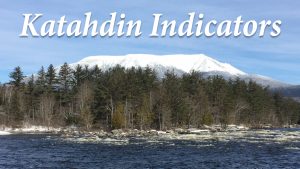Developing Economic and Community Resilience Indicators for the Katahdin Region
 Institution: University of Maine
Institution: University of Maine
Sponsor: Senator George J. Mitchell Center for Sustainability Solutions
* Link to Katahdin Region Indicators Fact Sheets and Survey
Maine has many natural resources, but with approximately 90 percent of its land forested, it is a large contributor of ecosystem services—benefits that humans derive from nature—to the state, and most of the state’s communities rely on one or more ecosystem services to support their local economies.
The abundance of forests in Maine can be a blessing and a curse because of the tendency for communities to become dependent on a single ecosystem service (e.g., timber, recreation). Some communities in Maine have been dependent on one ecosystem service for decades, leading to hardship when sudden lack of demand for that single service or resource has occurred (e.g., recent mill closures), and a struggle with their identity associated with a potential shift in how these ecosystem services are primarily used (e.g., new manufacturing, recreation).
The Katahdin Region has been particularly impacted by significant job loss over the past decade. Community leaders and residents in the eight towns that comprise the region (Millinocket, East Millinocket, Medway, Sherman, Stacyville, Patten, Mount Chase, and Island Falls) are still trying to figure out what’s next and assess whether changes that have been made are leading to tangible improvements in the region.
As a result, stakeholders have approached researchers at UMaine and requested an unbiased assessment of the economic and social “well-being” of their communities so they can strategically apply resources and make informed decisions about how they can shape the future of the region and continue to take advantage of their abundant natural resources in a sustainable manner. This research develops both qualitative and quantitative metrics, or indicators for measuring socio-economic resilience, to assess baseline values and perceptions of the community.
It is also developing methodsto consistently quantify tipping points and measures of success that can be tracked over time, both within the region and beyond. The research will develop methods to ‘transfer’ the knowledge and responsibilities of this work to members of the community so that they can sustainably and successfully use the findings to assist with development and lead efforts to update these indicators over time
Resilience indicators have been used to measure the ability of a community to return to a state of equilibrium through adaptation after an external shock has caused drastic changes to the community. Most resilience research has focused on natural disasters using a wide range of methodologies, while this work will investigate the impact of what is considered an economic disaster.
Recent resilience studies have used a combination of factors to measure resilience, including: economic diversity, financial resources, natural resources, planning, policy control, good governance, community and social capital; where each factor has a number of indicators that can be used to measure that factor’s contribution to a community’s resilience.
The use of these indicators could be particularly helpful for Maine’s rural towns that have experienced great economic depression and heavy out-migration after the closing of a local paper mill that provided high wage jobs to many of the towns’ residents.
Seed funding from the team’s research partner The Nature Conservancy produced a draft set of indicators from 2000, 2010, and 2016for each town in the region using data from public sources such as the US Census Bureau, Maine Revenue Service, and Maine Department of Education.
This project will extend this component of the work by collecting a wider set of indicators applicable to the region, adding time periods to the initial baseline analysis, and using statistical analysis to draw inference on which indicators are best at quantifying and tracking desired change in the Katahdin Region over time. The methods and findings from this analysis could also be extended to other rural communities in Maine and the U.S., particularly because it is highly reliant on publicly available data presented at the municipal level.
Team Leader
- Adam Daigneault, Assistant Professor of Forest, Conservation, and Recreation Policy, School of Forest Resources (SFR), Faculty Fellow, Mitchell Center
UMaine Team Members
- Linda Silka, Senior Fellow, Mitchell Center
- Sandra De Urioste-Stone, Assistant Professor of Nature-Based Tourism, Mitchell Center Faculty Fellow
- Mindy Crandall, Assistant Professor of Forest Management and Economics
- Aaron Weiskittel, Professor of Forest Biometrics and Modeling, Mitchell Center Faculty Fellow
External Partners
Resources:
News Article: Looking Back, Moving Forward
